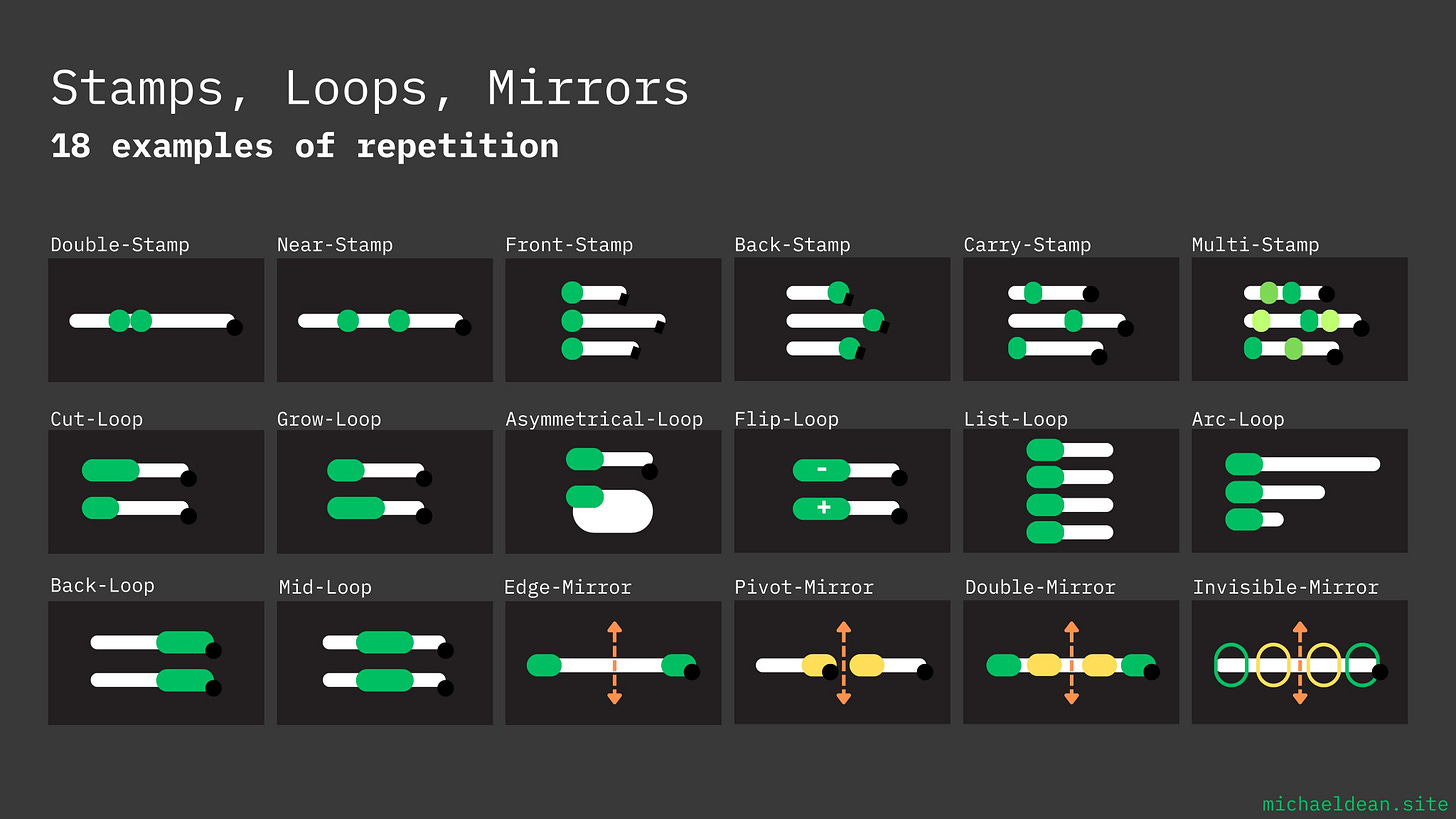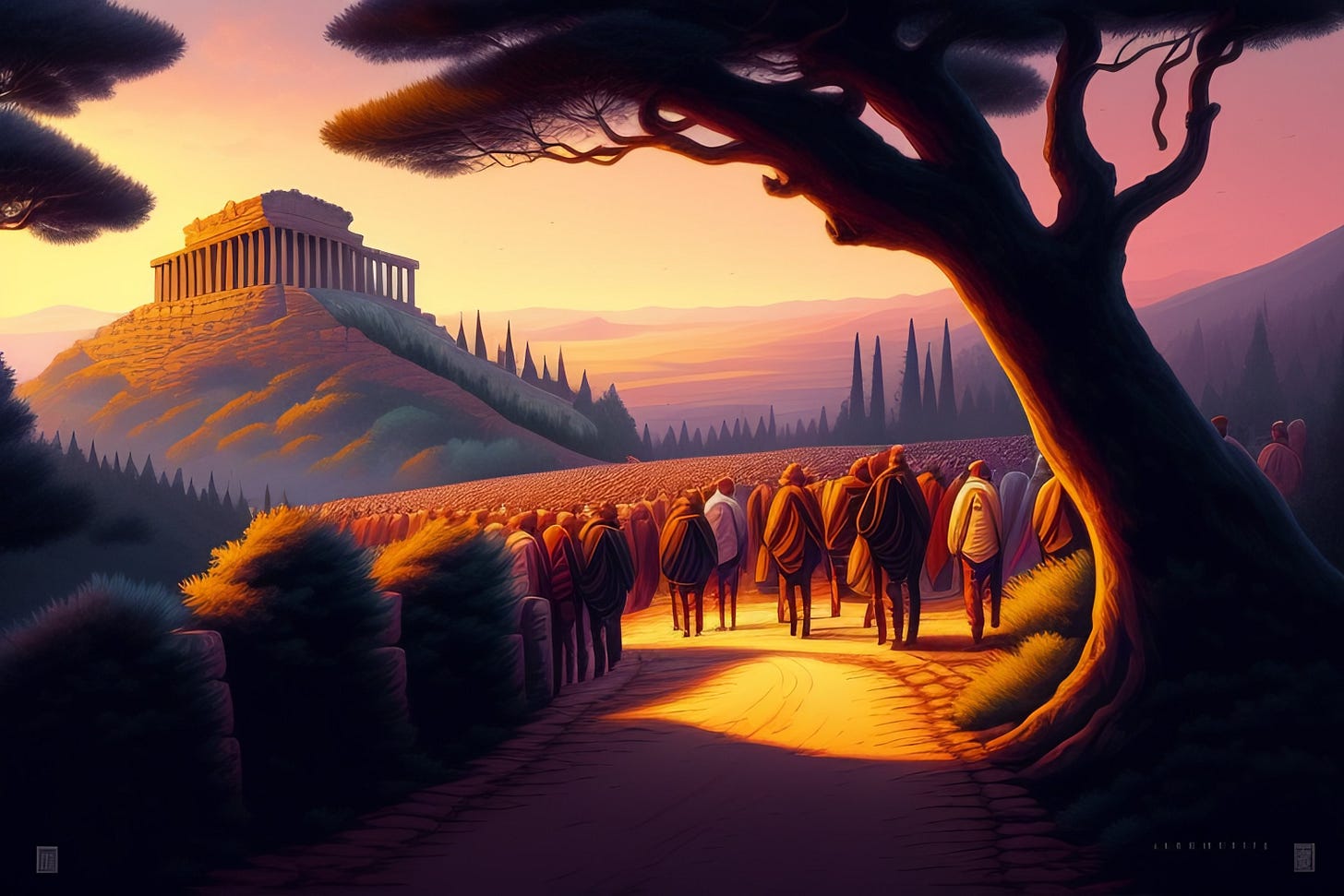About-WIP
Welcome to Dean’s List.1
Deconstructing words & worlds
From Charlie Becker’s Castles in the Sky
“Encountering Michael Dean’s writing is a mashup of experiences: it’s like reading Hunter S. Thompson2 the gonzo journalist, and Neal Stephenson3 the cyberpunk novelist (circa Snow Crash), combined with stumbling upon one of those long forum posts you encounter deep on the internet that almost seems like an alien intelligence because it is able to thread so many needles at once.”
Who’s Michael Dean?4 —
Background: I’m an architect5, turned virtual reality developer6, turned half-pseudonymous7 writer and editor. After molting and meandering, I’m looking to build a career online on my own terms.
Experience: In the last 3 years I’ve designed the curriculum for Write of Passage8, given feedback on 1,000+ drafts, edited and structured the Ultimate Guide to Writing by David Perell, and published over 300,000 words myself.9
Known for: I’m known for10 visual analysis11, logging my daily thoughts12, Greek Orthodoxy, unorthodox theories, living in Queens, a family Christmas Tree farm business, my neighbor Wilbur Doyle, a 1956 typewriter13, wearing glasses with cameras in them, a thesis on psychedelic therapy, a secret obsession with Terence McKenna, and lists.
From Garrett Kincaid’s Get Schooled: The Ultimate Guide to Michael Dean
“He’s a semantic savant, a lexical technophile, a feedback fanatic, The Clarity King. He’s a sage of the craft … He was clearly curious, a proud polymath, and a self-proclaimed “niche-hobbyist.” And, like me, he was an editor and a language-lover, despite not studying English … I felt an intense familiarity, but it wasn’t because of what he wrote. It was because of how he wrote.”
Why Subscribe? —
CRAFT: Learn patterns of essay structure & writing voice through visuals14
PROCESS: Get unstuck on your first draft through reverse outlining15
LESSONS: Understand history’s artists to defy the age of the algorithm16
LOGS: Read logloglog & get inspired to capture more of your life in writing17
AI: Follow along as I build an AI-powered text editor18
ESSAYS: Glimpse into occasional bits of futurism and science fiction19
SUBSTACK: If you’re interested to setup a website and start writing online20
Some of my favorite comments on Dean’s List —
“Your newsletter is probably the most value adding thing in my inbox now! Love these pieces focused on deconstruction.” — Atom Go Tian
“This had me think and laugh so hard my head’s in pain.” — Silvio Castelletti
“World-class, cutting-edge thinking, Michael, matched by your pitch-perfect writing style. Thank you.” — Mike Goodenow Weber
“A giant brimming bowl of delicious turns of phrase :)” — Kevin Brennan
“No one has inspired me to smoke weed again more than you just did. And I've been to Amsterdam 5 times or so this past year.” — Yehudis
Links —
My latest essay: Burn Down the Stage
My first essay: Studio Culture
Essays categories:
A full chronological index of all my posts
Follow me on Twitter: MichaelDean_0
A sample of my newsletter: logloglog #3
My most recent thoughts: Logs
A full archive of all my logs:
Contact me at michael@michaeldean.site or DM me on Twitter for editing, coaching, collaborations, analysis requests, Zoom rendezvous, IRL rendezvous, praise, complaints, or AMA.
Footnotes (WIP):
This About page: footnotes is a meta-layer of uncompressed honesty (About pages are usually about sleek compression). Also, this about page is a bird’s eye view of my whole Substack. A fractal puzzle. Every essay on my Substack is a hyperlink within the page.
HTS
I was tempted to answer this question with something snappy like: “If Frank Lloyd Wright and Virginia Woolf had a child with extreme OCD? The John Madden of writing visualization? Mr. Keating on acid?” You become more legible when you contrast yourself against something already baked into cultural consensus.
Architect
VR developer
Half pseudonymous — I’m aware of the cosmic joke that the SEO for Michael Dean will forever be haunted by an MTV reality star (NSFW).
100,000 words
“known” — blessing of being obscure and unknown — confirm that at least 2 people
logs
Get a typewriter
As an editor, it’s a blessing to have a typewriter. I also recommend it to anyone who gets stuck perfecting their opening sentence for 25 minutes. The inability to delete is the key feature here. There’s only one direction: forward. It’s a great tool for getting words on the page, and for building the habit of rewriting. Here are a few one-page essays I wrote on a typewriter.
While not identical, I also recommend the tool: The Most Dangerous Writing App. It deletes your text if you stop writing for more than 5 seconds, and helps silence the analytical mind.
Unlock your writing craft with visuals
I study writers intensely and visually, with the intention of subconsciously absorbing their tricks. Through architectural diagrams (shapes, lines, colors), you can instantly make sense of the invisible patterns behind the page. Check out my visual threads on the repetition of Kurt Vonnegut, the humor of David Sedaris, and the storytelling of Seinfeld.
I’ve also written essays about the prose of Jack Kerouac, the observations of David Foster Wallace, the lists of Hunter S. Thompson, and the spotlights of Virginia Woolf. Sometimes I’ll even do impressions.
Deconstruct your process
The editing and re-writing writing process is messy and non-linear. I often map out my own process in real-time to understand how ideas evolve. I’ll write essays and coin terms to help you unfuck your first draft. Use reverse outlines to see what’s on the page, saturation to make sure patterns are legible, and flash feedback to track resonance across your essay.
Learn from the history of artists
Any modern writer needs to zoom out beyond the Twitter/Substack bubbles where everyone tends to copy each other. There are artists across history, across mediums, who have timeless solutions to the problems that feel new.
In The Mucha Method, I wrote about how a Czech painter balanced commercial on-brand work with radical off-brand experiments.
In this thread on Jack Kerouac, I write about the consequences of fame (and the incomplete meme of On the Road).
How Beeple commit to a time cadence
I have a few other essays on the mindset of an artist, about being unpredictable, building a diehard audience, writing for your grandkids, and the importance of shaking up routines every 1,000 days.
Write down all your thoughts tomorrow
In December 2021, I started an experiment called “logloglog.” It was very much inspired by reading the Book of Disquiet by Fernando Pessoa, and very much feeling like I was occupying the full nature of his consciousness in 1920’s Portugal. I’ve done this for over 500 days now, and wrote a post on the value of doing this.
I’d say this is my most important habit as a writer. It’s main-note-taking system, and it all exists in the form of 20 text files. The real goal here is to be aware of your half-significant thoughts during the day, and to turn them into prose.
Since December 2021, logged 89% of days, and shared over 2,000 posts. Around 5 ideas a day, sometimes a stupid breadcrumb, sometimes 1-2 sentences, and sometimes it accidentally blooms into a full-essay. It’s a strategy of flowing with the dao, of letting ideas emerge when they’re ready, and practicing prose even on non-important ideas.
Here are my latest logs, and here are my archives for each month in 2023: January, February, March, April, May, June.
Share your stories
Write yourself onto the page. Fiction helps you experiment with prose, and auto-fiction brings the rich and wide-range of experiences into your writing. Placemaking, sketching, vignettes.
I’ve written about things as menial as a 10 minute walk through New York City, the experience of being late for the airport, and a weekend trip upstate.
Sometimes, I’ll condense experience into short-stories that deviate from reality, like this one about my strange neighbor.
I’ve even written about my experience in social VR networks (the Metaverse) from the first-person point of view, ranging from a corporate Facebook Connect Stream, to an underground society of raccoon coders.
Embrace AI
Everyone is freaking out about AI automating prose, but there’s actually a bigger opportunity. GPT-4 can help writers code their own tools. I’ve been dabbling. I’m working on tools for reverse outlining, rhythm analysis, log resurfacing. In Margin Matchmaker I wrote about the power of AI as a second brain. The more digital writing we have online, the more likely a future AI model will be able to digest it and continue our intellectual efforts. (Weirdly, writers can turn themselves into chatbot heirlooms for their great great grandkids).
Admit that the future is weirder than you can suppose
Through starting a VR company, I introduced over a thousand people to their first ever “immersive” experience. I’ve written about my background in XR, how I wear AR glasses every day, and how mature XR (2030s) will change the world as if teleportation was inveted
I’ve written about the need for XR-UI innovation, how NFTs will make more sense in the Metaverse, the hype around the MARS House, what it’s like playing mini-golf in VR, and how the Metaverse will ultimately resemble a digital Las Vegas.
I generally hope to help you make sense of a rapidly approaching, increasingly weird future (the end of linear history).
“The architect must be a prophet... a prophet in the true sense of the term... if he can't see at least ten years ahead don't call him an architect.” — Frank Lloyd Wright
Admit that the past might be misunderstood
As much as I daydream about the future, there’s something fascinating about the vast past. Particularly, it’s strange how our current impressions of the past might be incomplete.
In studying the ancient world, it surprised me that Eleusinian Mysteries might have been centered around a psychedelic ritual that enabled initiates to reliably hallucinate a Goddess from their folklore.
I’m currently on a research binge of St. Paul biographies and the Dead Sea Scrolls, and think there’s a chance Christ was crucified in 83 BC.
I’m intrigued by the idea of patterns and invisible loops through history.
Get on Substack
From Substack of Burst:
Substack is evolving faster than I can update my model of it. It’s no longer just an ‘email newsletter’ platform. It’s the trifecta for online writers: email distribution, network effects, and a personal website. It’s an all-in-one solution. This wasn’t the case a few months ago.
For new writers, I seriously recommend starting on Substack instead of starting your own website. It’s a pain to manage two things. And now, you can basically turn a Substack into your own site.











